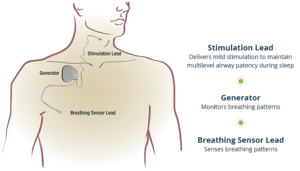Upper Airway Stimulation Treatment for Obstructive Sleep Apnea?
As more people become diagnosed with Obstructive Sleep Apnea, there is an equally increasing number of people who find themselves unwilling or unable to wear CPAP. Is there a solution that doesn’t require a mask and hose, or a mouthpiece? Inspire Therapy is this type of treatment, and many people are asking what it is and if it could work for them.
What is Inspire Therapy?
Inspire Therapy is a relatively new technology that is approved by the FDA for moderate to severe obstructive sleep apnea. Although CPAP is still the most effective treatment for moderate to severe sleep apnea, Inspire may be an option if CPAP has been unsuccessful for you. Inspire is an implanted device (inserted into your body) that monitors and works with your breathing to ensure your airway stays open when you sleep. In order to implant the device, three small incisions will be made in your body during an outpatient surgery procedure. During surgery, you will have general anesthesia but can go home the same day. The picture below shows the placement and purpose of each of the three Inspire components.
How does Inspire Therapy help with Obstructive Sleep Apnea?
While you sleep, the therapy monitors each breath you take. Based on your individual breathing pattern, the system delivers mild stimulation to the hypoglossal nerve (this nerve controls the movement of your tongue) and other airway muscles. By stimulating these muscles, your airway stays open when your sleep.
This therapy is controlled by a handheld remote, which you will be given and taught how to use as part of the education process.
Is this therapy right for everyone?
This therapy is not right for everyone. According to the Inspire manufacturer, this therapy is indicated if:
- You are at least 22 years of age
- You have moderate to severe OSA (AHI range from 15-65 and <25% central apneas)
- Documentation that you are unable to use CPAP
- You are not significantly overweight. This therapy has not been tested on people with a
BMI <32. Additionally, people who are extremely overweight tend to have excess fatty tissue in the neck are that pushes in on the upper airway even with the Inspire stimulation.
If you are not sure of your BMI, use the calculator at the end of this page.
Other considerations:
To be considered for this procedure, you must also have a certain type of airway anatomy. As part of the evaluation process, you will have a sleep endoscopy. A sleep endoscopy is a diagnostic test that is done under sedation and is usually performed by an ear, nose and throat physician. This test evaluates how severe your airway blockage is by evaluating the concentric collapse. If a patient has complete concentric collapse in their airway, it means that both the soft part of the roof of the mouth (soft palate) and sides of the throat completely block the airway. Individuals with complete concentric collapse are not candidates for Inspire therapy.
If you routinely need MRIs, some models of the Inspire Therapy are not compatible with MRI machines.
What happens after the Inspire is implanted?
Your Inspire implant will be activated three to four weeks after your surgery. During an appointment, your doctor will turn the system on for the first time. At this time, your doctor will establish your personal settings and show you how to use the device.
Additional visits may be needed to adjust settings. You will also need to have an overnight sleep study to be sure that settings are adjusted to be most effective.
Is this procedure covered by insurance?
To be considered for coverage, you must first be approved as an appropriate candidate for this therapy. According to Inspire, insurance currently covers this procedure on a patient-by-patient basis.
If you have additional questions or to find a doctor who performs this procedure, please visit the Inspire website at www.inspiresleep.com.

